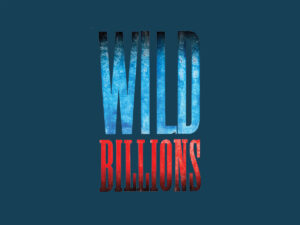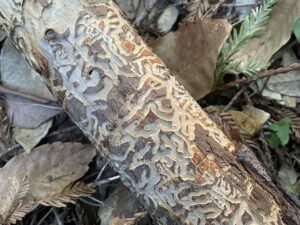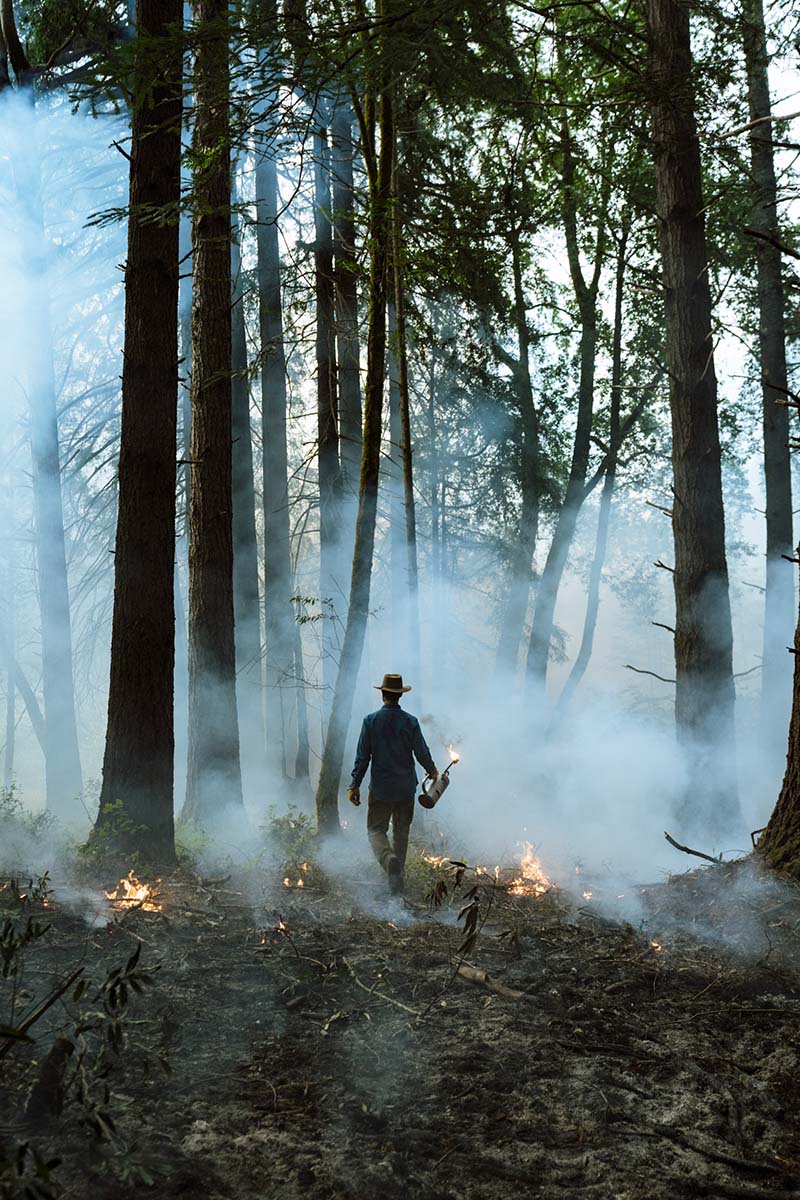
As a ceiling of wet winter fog gives way to the morning sun, about two dozen people gather on a small farm in western Sonoma County. Their attention is focused on a lithe young woman in heavy trousers and leather work boots.
“We’re looking at a max temperature of 64, a minimum humidity of 64 percent, a peak wind of 6 miles per hour east-southeast,” says Sasha Berleman, the director of Fire Forward, a prescribed fire program that teaches laypeople to burn overgrown forests and meadows to help prevent extreme wildfires.
This January morning, the ground is damp, but the breeze may yet dry out things enough for fire to catch. Berleman, who holds a PhD in wildland fire science and has been setting fire to landscapes since 2009, points behind her to an incline densely wooded with Douglas fir, tanoak, bay, and madrone.
“We’re going to be on that opposite hill, burning down to the road,” she says. The plan is to burn about 15 acres.
A small wildfire torched this hillside last June and miraculously didn’t blow out of control. Instead it fizzled after burning just a little more than two acres, killing only a handful of mature trees. But the owners and residents of Green Valley Farm + Mill in Sebastopol took it as a warning. Collaborating on a pro bono basis with Fire Forward, a project of the nonprofit Audubon Canyon Ranch, and local fire officials, the owners began to draw up a plan, concluding that their land, like so much of California’s open space, had been deprived of fire for decades. The farm’s owners spent months and hundreds of hours clearing overgrown brush, and in January, a month after the last heavy rains, they decided to burn.
Following a 30-minute briefing and introductions among the group, mostly volunteers and locals who have worked together before, the crew don hard hats and backpacks with drinking water for the day. They follow a steep fire road up to a high ridge. The Fire Forward support truck arrives behind them, and eager hands grab shovels, leaf blowers, chain saws, and heavy steel fire rakes. For an hour they scour out fuel breaks—three-feet-wide ribbons of bare earth that run from the valley floor to the ridge. Wildfires can jump freeways, but the gentle flames of the prescribed fire will be contained by these strips. Finally, with shakes of their drip torches—canisters of diesel blend with burning wicks—they begin flinging arcs of fire across the forest floor. Smoke fills the air as small flames eat up leaves and twigs.
Fire of this nature—that is, low-intensity fire, often started by people—frequently visited California’s varied landscapes for thousands of years. But for the last 200 years fire suppression laws and decimation of Indigenous tribes who practiced burning have led to landscapes dense with vegetation. Today, the federal government, state officials, and a growing number of communities are reversing course, holding up prescribed fire as an essential tool in California’s effort to prevent catastrophic wildfires.
In January 2022, the U.S. Forest Service introduced a 10-year plan to clear combustibles from 50 million acres of forest and rangeland using prescribed fire and thinning. The program skims its funds from Congress’s trillion-dollar Infrastructure Investment and Jobs Act, passed last November, and could be of particular service in California, where more than half of the forested land is federally owned. President Biden’s Build Back Better plan, while its future remains unclear, has also aspired to dedicate billions to improved management of fuel-loaded woodlands.
At the state level, legislators recently passed laws that make prescribed burning—including tribal cultural burns—a hallmark of forest management policy. A sense of urgency has also reached the office of Governor Gavin Newsom, who has budgeted billions toward preventing wildfires and improving forest health. The proposed 2022–23 budget adds $1.2 billion for fuel reduction, prescribed burning, and other forest management practices. This comes four months after Newsom signed the $1.5 billion Wildfire and Forest Resilience Package, which dedicated at least $88 million specifically to prescribed burning programs.
Most of this money will flow through the California Department of Forestry and Fire Protection, or Cal Fire, over the next three years. It will fund Cal Fire’s own burning and vegetation thinning work and trickle into the coffers of local entities like prescribed burn associations, resource conservation districts, and tribal-based burning efforts by way of grants.
Berleman’s small fire crew, and others like it around the state, are at the leading edge of a neighborhood-level change. “Communities are rallying for this,” says Lenya Quinn-Davidson, a prescribed fire community organizer in Humboldt County and the fire adviser with the UC Cooperative Extension program.
But good fire does not burn easily. Despite an infusion of money and enthusiasm, a variety of administrative and logistical fuel breaks have stalled what might otherwise be a rapid increase in prescribed burning activity. Cal Fire has jurisdiction over burning on much private and state land in California and prohibits or discourages burning for a majority of the year, with almost complete bans in summer and fall. Add to these seasonal restrictions the staggering scale of the work: Tens of millions of acres of forest statewide are overloaded with fuel—dried leaf litter, tangles of dead wood, and thickets of seedlings. While prescribed-fire advocates talk a big game about burning a million acres annually, currently the prescribed burning conducted by Cal Fire, private landowners, and several federal agencies totals just a few tens of thousands of acres each year in California. And much of it is grassland, and that does little to address deadly and destructive forest fires.

Grassroots efforts, with neighbors helping neighbors small parcels at a time, are the solution, according to Berleman. “That’s how we scale up, that’s how we get to that one million acres a year of prescribed fire,” she says. Along with her Fire Forward work, Berleman helps run the Good Fire Alliance, a prescribed burn association, or PBA, based in the North Bay. It is one of nearly two dozen PBAs that have formed statewide in the past five years. They offer support and networking to assist landowners in safely using beneficial fire. While private property owners who obtain air quality permits and follow Cal Fire’s requirements can legally conduct prescribed burns themselves, working with PBAs or with individuals certified to conduct prescribed burns, called burn bosses, can make it easier. They handle permits, insurance, much of the planning, and liability waivers for volunteers. Collectively, these organizations are leaving their mark on the land. In collaboration with Fire Forward, the Good Fire Alliance members have burned several hundred acres in Marin and Sonoma counties in the past four years. Quinn-Davidson’s group, the Humboldt County PBA, has burned some 2,800 acres since it launched five years ago. At the time, it was the only PBA in California.
“And then they just started popcorning all over the state,” Quinn-Davidson says. She runs the California PBA website, a clearinghouse for associations around the state, and reports that 18 PBAs have formally launched statewide and another six, at least, are planning to do so.
“Everyone’s interested in this now,” says Redbird, a Pomo Indian artist and basket weaver who lives in Sonoma County and has been helping to teach and conduct prescribed burns for about 20 years. He says he was almost overwhelmed with requests to lead prescribed burning seminars shortly after the 2017 North Bay fires. “People used to laugh at me,” he says. “Now, they’re listening.”
Sonoma County resident Tessa Rissacher, who attended the Green Valley Farm burn, took Fire Forward’s prescribed burning training course, which can be completed mostly online, a year ago. She says it was an informed reaction to the surging wildfire crisis that has forced her to evacuate her home more than once. “I was tired of feeling helpless and confused,” says Rissacher, who has now volunteered with Fire Forward on two burns.
Chris Morales of Fairfax drove an hour to join the Green Valley Farm burn. Though he lives on a large rural property, regulations prohibit any burning for fuel reduction and wildfire prevention in his neighborhood. He hopes—maybe even anticipates—this will change in the future and it’s partially why he took Fire Forward’s training course. He sees prescribed fire knowledge as “a tool in the tool kit” of basic homesteading skills.
Up on the mountainside at the Green Valley Farm, Morales and the rest of the volunteers walk through the woods, waving their drip torches and dropping splotches of fire on the ground. But the mat of leafy, twiggy debris won’t light. The small spots of fire shrink and fizzle out, burning little more than diesel.
“It’s not even creeping,” one man observes.
Berleman radios her teammates down the mountainside, and, after most of a day’s work, they decide to quit and save their fuel. Next steps will include meeting with state fire officials to discuss the challenges of burning this north-facing slope in the winter months and to possibly gain Cal Fire’s approval to return here during summer.
“I’m hoping we can do this in July,” Berleman says.

Just a valley and a ridge to the southwest of Green Valley Farm, burning conditions are better, and three days later, the Fire Forward pickup truck lumbers up the dirt driveway of the Occidental Arts and Ecology Center (OAEC), a nonprofit research and education organization. Property co-owner and co-director of the center’s Wildlands Program Brock Dolman has spent decades restoring native ecosystems on the 80-acre site, and fire has been an important tool. He models his burning after traditional Indigenous practices, even starting his fires with a hand-powered wood drill. During a quick pep talk with the team, he nods his respect toward two Indigenous community members, including Redbird, who have come to help burn today.
“To your ancestral heritage, your DNA,” Dolman tells them. He then briefly outlines the history of the property, stating that tribes lived and burned here for millennia, and “then some white folk knuckleheads came along and clear-cut the shit out of it, vineyarded it, plowed it.”
To undo some of that ecological damage, OAEC residents burn the property’s meadows every few years. On grasslands, low-intensity fire fixes soil nutrients and resets germination cycles. It also offers human stewards the chance to plant desired native seeds, giving them an edge over invasive competitors. Dolman says this burn-and-seed strategy has encouraged, among other species, blue wild rye and purple needlegrass to flourish.
Today, the Fire Forward crew, plus about 10 helpers, will burn a four-acre patch of mixed woodland—mostly oaks, bay, and fir—where there’s been no fire in more than a century. It’s Dolman’s first woodland burn, placing him among the students. The Fire Forward crew hands out drip torches. “What do I do?” asks Dolman, inspecting the red canister and quipping that he’s just a “fossil fool.”
But using a drip torch is easy: You loosen a knob, allowing the diesel blend inside to trickle out, then light the wick and start tossing fire. Torches lit, the crew breaks into four squads—Alpha, Bravo, Charlie, and Delta—that disperse along the fire road, the uphill fuel break. When the topography permits, people usually ignite prescribed fires at an area’s highest point, just inches below the fuel break. Especially important in dry conditions, this technique lessens the fire’s ability to run away. A second line of fire burns about six feet below the first, and after a few minutes, these bands of flame meet and fizzle, leaving a beautiful six-foot ribbon of smoking black ash. Repeated downhill a strip at a time, the beneficial fire massages the forest.
Smoke clouds the woods, and one participant straps a disposable N-95 ventilating mask over her face. A moment later, a Fire Forward crew member suggests she take it off. The trouble is, it’s synthetic and could easily catch fire. Otherwise, nobody appears very concerned about the smoke—at least, no more than they would be while sitting at a campfire.
“Alpha, how’s it going?” a crew member asks into the radio. A voice bounces back: “Burning. Fuels are a little too wet. Could be better.”
The dry leaves and needles crunch underfoot, but residual moisture in the soil slows the fire. It takes babying to move the flames along, and the crews are using more diesel than they’d like to.
“We’re just wasting fuel at this point,” says Garrett Gradillas, Berleman’s right hand on the Fire Forward team.
Across the road from the Occidental Arts and Ecology Center, Sashwa Burrous has also restored fire cycles to his shared 10-acre parcel of mixed woodland. Like others recently introduced to good fire, he learned the basic dos and don’ts of prescribed burning through a Fire Forward training program two years ago. He is now a core member of the local fire community, friends with Dolman, Berleman, and her crew, and an experienced burner.
“You couldn’t walk through this forest a little bit ago, maybe three months ago,” Burrous says, pointing into a tidy grove of Douglas fir and oak trees a long stone’s throw from his home. Now, he suggests, one could hunt here, collect huckleberries, or forage mushrooms from the charcoal-black forest floor.
Burrous has also helped landowners on either side of him to thin and burn their properties, and they, in turn, are getting stoked. “One of my neighbors just bought a drip-torch,” Burrous says. “He’s super excited. He’s been texting me, saying, ‘Conditions look good! Let’s burn!’”
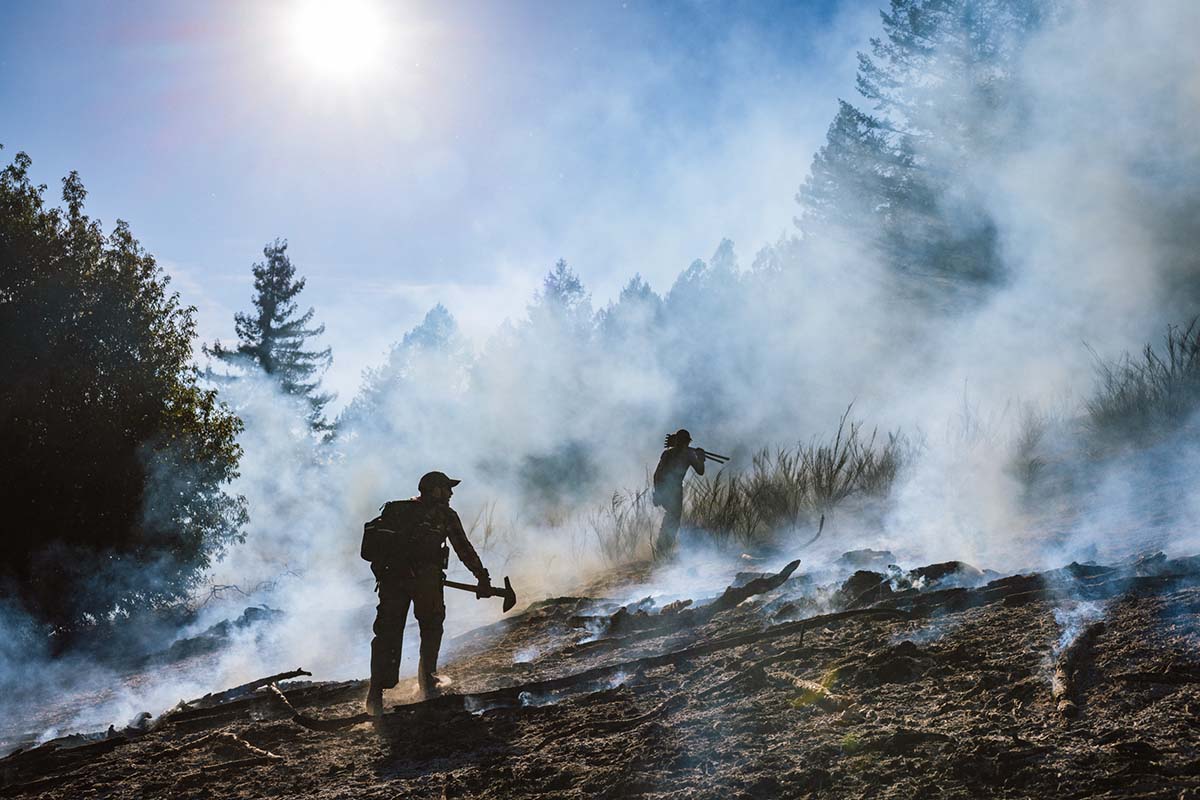
The era of American fire suppression may have formally begun with the Weeks Act of 1911, which commanded state and federal agencies to religiously fight fire on public land. However, its origins stem from the colonial genocide of Indigenous Californians, whose population plummeted from an estimated 300,000 in the 1700s to roughly 15,000 by 1900. This all but extinguished Indigenous burning traditions, and that any deep understanding of tribal burning survived through the 20th century is a wonder. And yet it did.
Scattered embers of Indigenous fire knowledge remain in far-flung corners of the state. Margo Robbins, a Yurok tribal member who lives in a community beside the Klamath River, is among the few bearers of the torch. When she was a child in the 1960s and ’70s, her elders continued burning small areas “under the radar,” she says. Tribal burning in that era was an act of defiance as well as a pragmatic effort to coax food and fiber from the landscape.
Today, Indigenous communities often distinguish their cultural burning from other types of intentional fire; they’re igniting small areas to thin out dead grass, facilitate acorn gathering, and prompt growth in plants used for basket-weaving material, for example. Reducing fuel loads that contribute to mega wildfires is not the primary goal, but a secondary benefit of cultural burning—exactly why the state wants to promote its use. And today, Robbins is passing on the skills she retained.
“We’re teaching the next generation,” she says.
In 2014, she established the Cultural Fire Management Council, a collaboration with other tribal members in the Klamath Basin to rebuild burning traditions among communities and families. Robbins says an uptick in cultural burning has noticeably affected the ecosystem. Deer have returned to areas where just a few years ago thick brush kept them out. Collecting berries and mushrooms is easier, and the soil moisture and stream flow, good for salmon and food-producing plants, have also visibly improved.
The Cultural Fire Management Council, working with Bill Tripp, a member of the neighboring Karuk Tribe, advised lawmakers in drafting SB-332 and AB-642, legislation intended to ease the administrative and legal hurdles currently impeding cultural and prescribed burning. Tripp has been burning around his community since age 4 and without adult supervision since age 8. He says his community currently burns just a few hundred acres each year, mostly around homes and structures, but he wants to “scale that up” and deploy good fire into large woodland areas, the way his ancestors did. He envisions a collaborative burning program of “prescribed fire with cultural objectives,” supported by state money and tribal knowledge.
Much in the way cultural burning takes place close to homes and roadways, good fire advocates believe prescribed burning should be initiated in and around suburban communities statewide—even in places as densely cluttered with residences as the East Bay Hills.
“It belongs there, too,” says Don Hankins, a Plains Miwok tribal member and professor in the Department of Geography and Planning at California State University, Chico. Hankins says bare-earth fuel breaks and defensible spaces around homes can set the stage for safely burning within communities, so that fire can go “creeping through neighborhoods” without damaging structures or mature trees.
New state policies aim to prep communities for such a close relationship with fire, and recent legislation authored by Senator Bill Dodd, SB-332, protects anyone conducting a prescribed burn from liability except those “whose conduct constitutes gross negligence.” Another recent state action created a $20 million insurance claims fund to back up landowners whose prescribed burns cause damage. Advocates say the dangers of controlled burns are sometimes exaggerated. A published review of 23,050 prescribed burns across the U.S. over many years reported an escape rate of just 1 percent. It also noted one minor injury and a single legal case resulting from fires that got away. But it does happen. The Colorado wildfire in Big Sur that burned 700 acres in January 2022 started due to embers from a recent pile burn—a collected heap of vegetation—according to investigators.
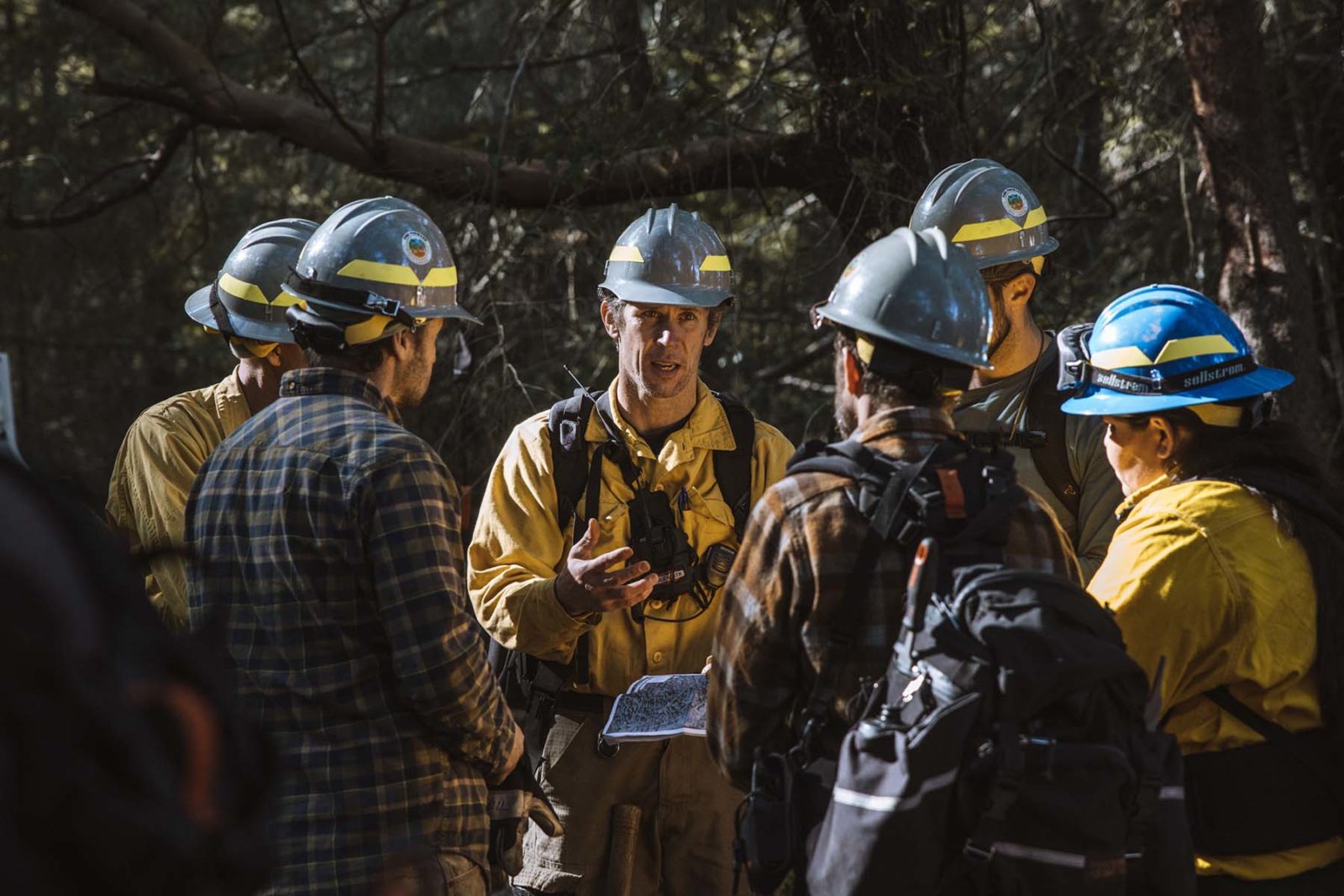
Even as prescribed fire becomes a mandate of state policy, with cash flow and community cheer fanning the flames, a good fire revolution seems years away. Many burning advocates claim Cal Fire’s restrictive permitting procedures impede rather than facilitate prescribed burning. Most years, starting in May and running through summer and fall—roughly the season when megafires have engulfed the state—the agency prohibits most intentional burning, pausing much of its own burning activity, too. At this time of year, often called the “burn ban” season, Cal Fire’s regulatory framework technically allows burning, but barely so. Landowners must apply for a free Cal Fire permit to burn, and typically the agency rejects the request. Only after significant rainfalls does Cal Fire lift the ban, for an interlude often referred to as the “open burning season,” making it so that almost any landowner can legally burn without a Cal Fire permit. While private landowners still need a 12-month permit from the local air quality management office that usually costs a few hundred dollars or less, it’s easy to get in most cases.
But during this season, even three or four weeks into a dry spell, lighting a fire in the woods is almost impossible. “By the time Cal Fire is willing to say yes [to a private prescribed burn], it’s likely that it’s going to be too wet to burn,” says Rob York, a professor of forestry at UC Berkeley with two decades of prescribed fire experience. York, among others, has publicly recommended that Cal Fire streamline its permitting procedures to accommodate more prescribed burns.
State officials seem to be listening. In 2020, the Newsom administration signed an agreement with the U.S. Forest Service to reduce fuels on a million acres of land each year, and Cal Fire is helping to orchestrate a collaboration with landowners, tribes, and federal agencies to substantially increase the intentional use of fire by 2025. State fire officials kicked off a program last spring to train and certify burn bosses: fire professionals qualified to help landowners safely burn on their properties. However, the program, mandated by 2018 legislation, has so far skunked: Nearly two dozen people took the course and not one has been certified by Cal Fire—a point of frustration for Quinn-Davidson, who helped design the program in hopes it would promptly produce a crop of eager burn leaders. And yet another new initiative, outlined in AB-642, requires the state fire marshal “to develop a proposal to establish a prescribed fire training center.” The proposal is due by July 2023.
Michael Wara, for one, is not satisfied with this pace of progress.
“That’s not fast enough,” says Wara, the director of the Climate and Energy Policy Program at the Stanford Woods Institute for the Environment.
Wara and his colleagues have estimated that between 10 and 30 percent of California’s approximately 100 million acres could benefit from fuel reduction programs, including approaches like prescribed fire. Wara recently drafted a detailed plan, funded by the Resources Legacy Fund, that erases California’s wildland fuel surplus in two decades or less, at the pace of a million acres and a billion dollars per year.
A long shot to begin with, and there’s a kicker: thinning and burning must be repeated in several years, and then again, and again, and again. “This is a treadmill that you never get off,” says Scott Stephens, a UC Berkeley wildland fire scientist.
The state budget’s promised funds include $20 million between 2020 and 2022 earmarked for “tribal engagement.” Cal Fire plans to dole out this money in the form of “Tribal Wildfire Resilience & Forest Health Grants across the state to implement forest health and fire prevention activities, including prescribed fire to promote traditional ecological knowledge,” according to an emailed statement from Christine McMorrow, a Cal Fire spokesperson.
Tripp remains dubious this will stoke cultural burns. “Twenty million doesn’t go a long way,” he says. He speculates it could go toward the prescribed fire training center required by AB-642. “We think that should be built here,” he says.
Placing the training center in the town of Orleans, on Karuk territory, in Humboldt County, would give a boost to fuel reduction and prescribed burning projects on tens of thousands of acres now in the planning stages, Tripp says. Doing so would also serve as a mitigation for past atrocities. “Having fire taken from us was one of the great systemic injustices tribes have endured, and this would help remedy that,” he says.
Construction alone, plus a year of staffing, could burn through most of the $20 million, according to Tripp. More money would help, and Tripp says tribal leaders are making “a pitch for including $20 million in the California state budget this year” specifically to assist Karuk cultural burning programs, the training center included.
But the other law being celebrated as a boost to prescribed burning has run up against a problem—a legal loophole that Tripp says effectively cripples SB-332 when it comes to tribal land. The law protects from liability those who conduct prescribed fires in a reasonably responsible manner, but it requires, among other things, that a protected burn be authorized by specific sections of state law. That’s a legal impossibility, Tripp says, because these code sections do not recognize tribal approval to burn. It’s a complicated problem that Tripp says was an unforeseen accident and that “some lawyer-type folks” are now trying to fix with some language tweaks for the next legislative cycle.
The state budget also allocated $50 million over two years for “prescribed fire and hand crews.” Much of the money will support Cal Fire’s own prescribed fire work, but prescribed burn associations can tap into it through grant applications, according to Cal Fire’s McMorrow. However, groups that receive Cal Fire prescribed burning grants will be subject to the California Environmental Quality Act, which can require costly environmental analyses for project planners. That’s a hurdle some prescribed burn associations are reportedly reluctant to tackle, preferring to take private funding instead.
The biggest barrier to a prescribed burning revolution may simply be the immense labor involved in returning fire to neglected forests. These woodlands usually need “treatment” with chain saws, clippers, and chippers before fires can safely burn. Such work is slow, cumbersome, dangerous, extremely arduous, and expensive—at least $1,000 an acre on average, by Wara’s estimates.
On many small projects, like at Green Valley Farm, volunteers gladly do this work. Still, it takes a village to treat and burn just a few acres. These events require coordination, leadership, and planning, and at the last minute, unexpected weather conditions can cause cancellations and delays lasting an entire year.
Advocates frequently refer to “scaling up” their burns to the “landscape level”—ostensibly hundreds or thousands of acres. Berleman says drones could drop small firebombs into the middle of large forest areas while hand crews work the perimeters, a strategy that could allow large swaths to burn in a day. Tentatively planning such a burn, Berleman has her eye on the seaward slope of Mount Tamalpais, where the organization she works for, the Audubon Canyon Ranch, owns a vast and overgrown property. “I really want to get in there before a wildfire does,” she says.
Tripp maintains that in the Klamath Valley, nighttime fog and humidity in the summer can make for safe burning most of the year. He describes how parcels of woodland a few hundred acres in size could be lit in the evening, then essentially left to fizzle out after dark as the fog rolls in.
Others see a chance to go big by leveraging the impacts of recent wildfires. In 2020 alone, more than four million acres burned across the state, much of it by relatively low-intensity flames that left mature trees standing and the ground beneath charred but tidy and free of dangerous fuel—essentially achieving the effects of a massive prescribed fire.
“That’s a huge opportunity,” Wara says. Prescribed burning alone, without mechanical and manual thinning, is cheap and easy, with estimates ranging between $50 and $300 an acre. In fact, Wara’s forest treatment plan gets a lot more palatable when wildfires constitute part of the workforce: they’ve burned through about 10 million acres of forest in the past decade—land where wildfire risk has been effectively erased, at least for a while.
Quinn-Davidson also sees opportunity in the ashes. “The August Complex burned a lot of area just like we’d want a prescribed fire to burn,” she says, referring to the 2020 fires of northwest California. “It would have taken us 20 years to achieve that ourselves.”
Some experts say California needs a specialized prescribed fire workforce—a shift from the current system of employing state firefighters to double as prescribed fire applicators. Instead, says Chris Field, a researcher with the Stanford Woods Institute for the Environment, the state must develop a workforce “of people whose job description is fire-risk reduction.”
Developing economic incentives to thin forests, he says, would help in reaching this goal. Field suggests creating new markets for wood products made from small-diameter trees to generate lasting interest in thinning overgrown forests. His colleague Wara envisions a system in wildfire-prone areas where communities pay into funds that support work crews. “We need to build a different kind of rural economy in California where stewardship is a business opportunity.”
No matter how swiftly this all plays out, and even though some wildfire has been beneficial, great swaths of conifer forest will be lost. UC Berkeley’s Stephens says more than 50 percent of the Dixie Fire, which burned nearly a million acres in the summer and fall of 2021 in northeast California, burned at a high intensity, killing essentially everything in its path. Contiguous “patches” of forest larger than San Francisco were left an ashy wasteland.
Much of this acreage, Stephens says, will become dominated by shrubs that outcompete many tree species. Once this happens, he adds, the transformation will be very difficult to reverse. “How do you get a forest back?” he asks. “That will be one of the biggest challenges in the coming century.”
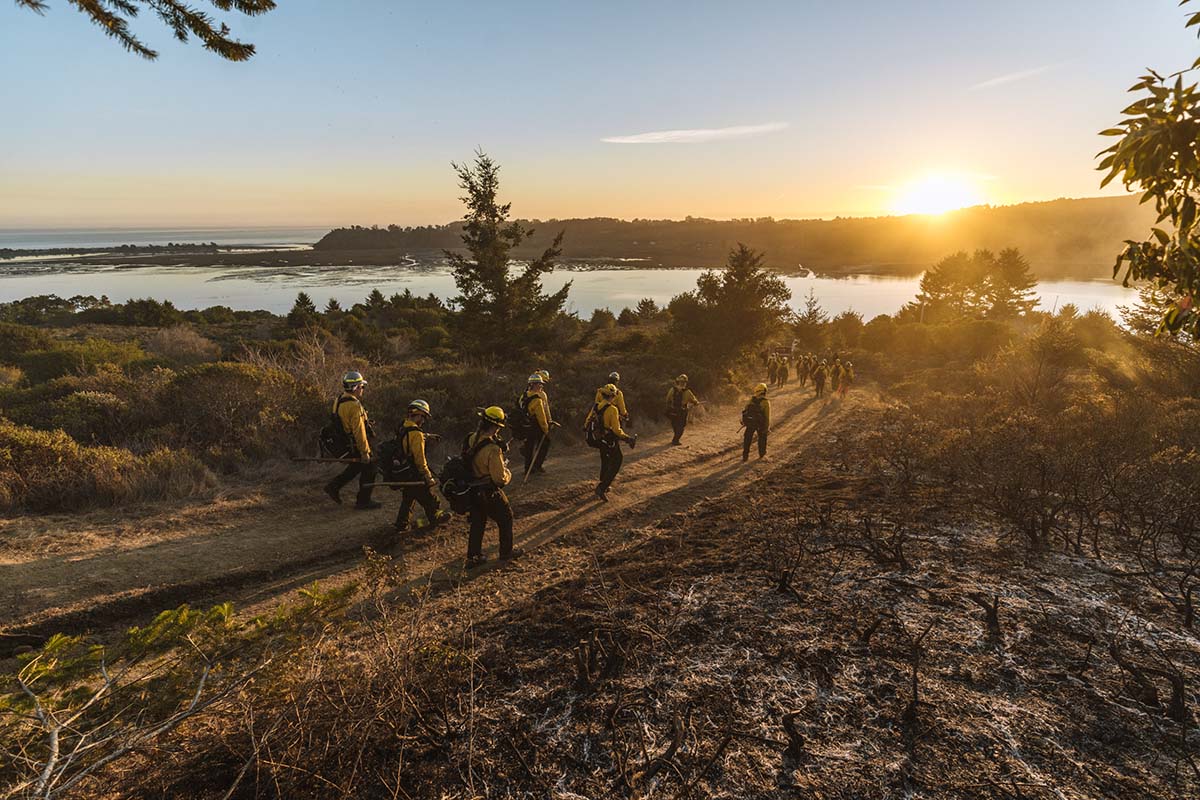
From miles away, a plume of smoke can be seen spewing from the woods at the Occidental Arts and Ecology Center. Years’ worth of vegetation fuel buildup vaporized in a few hours, and the job will hopefully deflect any wildfire that passes through the area. In a few years, the community will do it again, and with less laborious prep work the second time around.
To finish the day, the burn team gathers beneath a midsize redwood tree, probably about a century old, and lights a ring of fire around its base. Given the chronology of tribal genocide and fire suppression, it’s unlikely this tree has ever felt fire. For several minutes, this monarch of the property towers over a dreamy haze of smoke and glowing coals.
“Don’t worry,” one of the volunteers says cheerfully to the tree as flames kiss its toes. “You’re going to be here for a long time.”
In this patch of forest, good fire is back.


